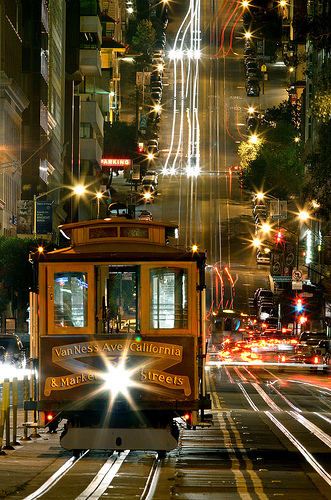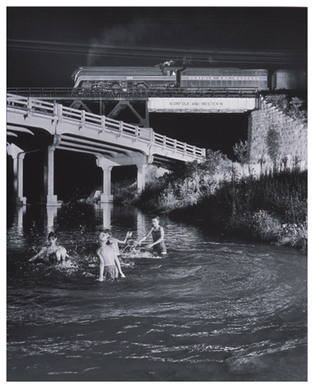Our 2011 calendar has just gone to the printer. We should have them in stock at our San Francisco Railway Museum around Labor Day. One of our best contributors over the years is Market Street Railway member Bill Storage, who takes fantastic night shots in particular.

In Bill’s photo blog, “The Eye Game,” he describes what went into some of his distinctive historic transit shots, like this one of a California Street cable car. It’s well worth a read, even for non-shutterbugs.
In this era of digital photography where the governing mantra seems to be, “No problem, we’ll fix it in Photoshop,” Bill demonstrates a dedication to traditional methods, including the use of old-fashioned flashbulbs, sometimes in multiple arrays, to get just the right lighting effect. Bill’s photography makes scenes we’ve seen over and over again look fantastically fresh. A rare gift.
Bill’s work is reminiscent to me of a man I consider the greatest railroad photographer of all time. His name was O. Winston Link and he chronicled the dying days of steam on the Norfolk & Western Railroad. He died in 2001. Three years later, a museum celebrating his photography opened in Roanoke, Virginia.

Link was a commercial photographer with an affinity for trains. When he heard that the N&W, the last large scale user of steam locomotives, was converting to diesel in the 1950s, he launched a project to capture some of the magic of steam. But he went so far beyond the “three-quarter view” of the vehicle itself to capture slices of America – admittedly posed – that could be described as the photographic equivalents of Norman Rockwell paintings.
Such photos as the 1956 Hawksbill Creek Swimming Hole, shown here, are masterpieces of lighting, with dozens of flashbulbs arrayed just to illuminate the kids in the pond at the precise moment the steam locomotive thunders by on the trestle. No motor drive: one shot only.
Some of Link’s best work is captured in the 2000 book The Last Steam Railroad in America. (If you decide to buy, following this link will earn Market Street Railway a commission from Amazon.com)
The more you look at Link’s work, mostly black and white but some color too, the more evocative it becomes, even if you’re not a railfan.
That’s another thing Bill Storage has in common with the great Link: the ability to put transportation vehicles into a living context, make them seem like an integrated part of their environment, rather than something apart. That’s what we try to do in our calendar every year as well. We’ll post here the moment it’s available at the museum and at our online store.
Spectacular photo, by Mr. Storage, of the California Street Cable Car. I hope it will be in the 2011 Calendar. I agree with Rick, the writer, Mr. O. Winston Link was the best Railroad Photographer of all times. Sometimes the History Channel will have a railroad program with his photos and story. Don’t miss it!! He also took spectaular photos, mostly at night.
Some railfan photographers try to take photos that emphasize the machinery, and they forget that if there weren’t any people, there wouldn’t be any machines. Although “roster shots” have their place, showing trains and streetcars in an active setting, with passengers waiting to board or workers tending to the myriad tasks involved in keeping the trains or trolleys running is a vital part of the photographic (and nowadays, video) record.
I really enjoy the streetcar photography you post, thank you for all photos you’ve been posting.